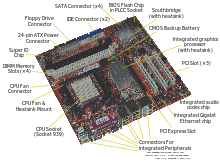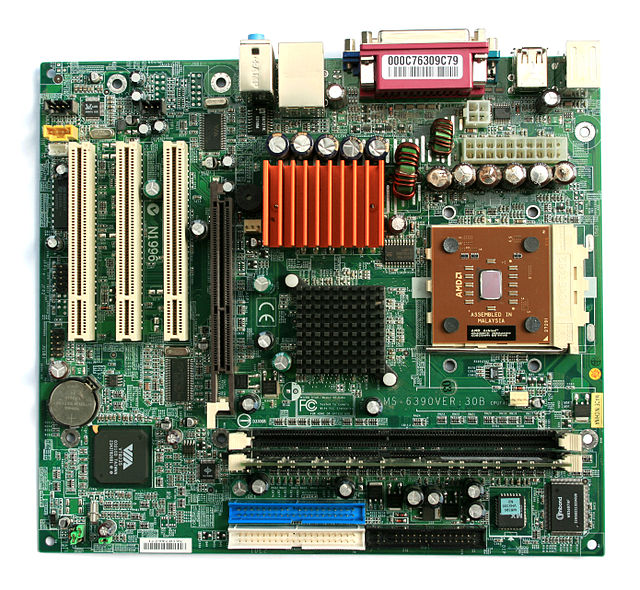Difference between revisions of "Motherboard"
(Created page with "A motherboard (sometimes alternatively known as the mainboard, system board, planar board or logic board,[1] or colloquially, a mobo) is the main printed circuit board (PCB) f...") |
|||
| Line 1: | Line 1: | ||
A motherboard (sometimes alternatively known as the mainboard, system board, planar board or logic board,[1] or colloquially, a mobo) is the main printed circuit board (PCB) found in computers and other expandable systems. It holds many of the crucial electronic components of the system, such as the central processing unit (CPU) and memory, and provides connectors for other peripherals. Unlike a backplane, a motherboard contains significant sub-systems such as the processor and other components. | A motherboard (sometimes alternatively known as the mainboard, system board, planar board or logic board,[1] or colloquially, a mobo) is the main printed circuit board (PCB) found in computers and other expandable systems. It holds many of the crucial electronic components of the system, such as the central processing unit (CPU) and memory, and provides connectors for other peripherals. Unlike a backplane, a motherboard contains significant sub-systems such as the processor and other components. | ||
| − | + | [[File:220px-Acer E360 Socket 939 motherboard by Foxconn.svg.png]] | |
A motherboard provides the electrical connections by which the other components of the system communicate (talk with each other). Unlike a backplane, it also contains the central processing unit and hosts other subsystems and devices. | A motherboard provides the electrical connections by which the other components of the system communicate (talk with each other). Unlike a backplane, it also contains the central processing unit and hosts other subsystems and devices. | ||
| − | + | [[File:640px-MicroATX Motherboard with AMD Athlon Processor 2 Digon3.jpg]] | |
Modern motherboards include: | Modern motherboards include: | ||
Revision as of 12:25, 28 October 2014
A motherboard (sometimes alternatively known as the mainboard, system board, planar board or logic board,[1] or colloquially, a mobo) is the main printed circuit board (PCB) found in computers and other expandable systems. It holds many of the crucial electronic components of the system, such as the central processing unit (CPU) and memory, and provides connectors for other peripherals. Unlike a backplane, a motherboard contains significant sub-systems such as the processor and other components.
A motherboard provides the electrical connections by which the other components of the system communicate (talk with each other). Unlike a backplane, it also contains the central processing unit and hosts other subsystems and devices.
Modern motherboards include:
Sockets (or slots) in which one or more microprocessors may be installed. In the case of CPUs in BGA packages, such as the VIA C3, the CPU is directly soldered to the motherboard.[citation needed] Slots into which the system's main memory is to be installed (typically in the form of DIMM modules containing DRAM chips) A chipset which forms an interface between the CPU's front-side bus, main memory, and peripheral buses Non-volatile memory chips (usually Flash ROM in modern motherboards) containing the system's firmware or BIOS A clock generator which produces the system clock signal to synchronize the various components Slots for expansion cards (the interface to the system via the buses supported by the chipset) Power connectors, which receive electrical power from the computer power supply and distribute it to the CPU, chipset, main memory, and expansion cards. As of 2007, some graphics cards (e.g. GeForce 8 and Radeon R600) require more power than the motherboard can provide, and thus dedicated connectors have been introduced to attach them directly to the power supply.[3] Most disk drives also connect to the power supply via dedicated connectors.

